Been searching the net for some more info on Ransomes and Rapier walking draglines, and not found much!!
Was the Ruston Bucyrus walking dragline a competitor to the Ransomes Rapier, or was this after Ruston were building walking draglines to the Ransomes design?
I see there are plenty of books on Ruston, anybody know of any on Ransomes and Rapier??
Anyone have any sales literature, etc for early walking draglines?
Early British walking draglines
-
Dah
- Posts: 395
- Joined: Sat Dec 29, 2012 10:45 pm
- Real name: Dave
- Has thanked: 18 times
- Been thanked: 68 times
- Flag:

Re: Early British walking draglines
Hi
As for as I know, Ruston Hornby became Ruston Bucyrus after their alliance with Bucyrus Erie was formed.
Ransoms Rapier were a separate company from Ipswitch and were a big player in both draglines and stripping shovels at one point.
Dave
As for as I know, Ruston Hornby became Ruston Bucyrus after their alliance with Bucyrus Erie was formed.
Ransoms Rapier were a separate company from Ipswitch and were a big player in both draglines and stripping shovels at one point.
Dave
-
Dah
- Posts: 395
- Joined: Sat Dec 29, 2012 10:45 pm
- Real name: Dave
- Has thanked: 18 times
- Been thanked: 68 times
- Flag:

Re: Early British walking draglines
Few more interesting facts - never knew that R&R built the turntable for the BT Tower!
Ransomes and Rapier constructed China's first railway, the Woosung Road (or Woosung Railway) from Shanghai to Woosung. The railway opened in 1876 but was dismantled by the local government the following year because it had not received the necessary approvals. The firm also supplied railway turntables in the early to mid-1930s.
During the First World War they produced shells, guns and tank turrets. The Stokes mortar was invented by managing director and chairman Sir Wilfred Stokes, knighted for the invention. His nephew Richard Rapier Stokes, MP was also managing director.
The company merged with Newton, Chambers & Company of Sheffield and formed the NCK excavator division to form NCK-Rapier who built walking draglines used in opencast mining.
Ransomes and Rapier built the model W1400 walking dragline called Sundew for The United Steel Company iron ore quarry at Exton Park, Rutland, England. At the time it was built in 1951, it was the largest in the world, weighing in at 1880 tons.
Ransomes & Rapier sold the right to their walking dragline technology and patents to Bucyrus International in 1988.
The turntable used to turn the revolving restaurant on the BT Tower was also built by Ransome & Rapier.
Ransomes and Rapier closed in 1987
Dave
Ransomes and Rapier constructed China's first railway, the Woosung Road (or Woosung Railway) from Shanghai to Woosung. The railway opened in 1876 but was dismantled by the local government the following year because it had not received the necessary approvals. The firm also supplied railway turntables in the early to mid-1930s.
During the First World War they produced shells, guns and tank turrets. The Stokes mortar was invented by managing director and chairman Sir Wilfred Stokes, knighted for the invention. His nephew Richard Rapier Stokes, MP was also managing director.
The company merged with Newton, Chambers & Company of Sheffield and formed the NCK excavator division to form NCK-Rapier who built walking draglines used in opencast mining.
Ransomes and Rapier built the model W1400 walking dragline called Sundew for The United Steel Company iron ore quarry at Exton Park, Rutland, England. At the time it was built in 1951, it was the largest in the world, weighing in at 1880 tons.
Ransomes & Rapier sold the right to their walking dragline technology and patents to Bucyrus International in 1988.
The turntable used to turn the revolving restaurant on the BT Tower was also built by Ransome & Rapier.
Ransomes and Rapier closed in 1987
Dave
-
fang
Topic author - Posts: 48
- Joined: Mon Dec 20, 2010 9:03 pm
- Real name: Andrew
- Has thanked: 1 time
- Been thanked: 1 time
- Flag:

Re: Early British walking draglines
Yeah I read somewhere that in the 80's R&R sold their walking dragline technology to Bucyrus.
But I have a R-B product range catalogue, unsure of the year but all cable machines from a 10RB to 150RB. Later design with the yellow-red colour scheme, and in there is an R-B 5w walking dragline!!
But I have a R-B product range catalogue, unsure of the year but all cable machines from a 10RB to 150RB. Later design with the yellow-red colour scheme, and in there is an R-B 5w walking dragline!!
-
FOWLER MAN
- Posts: 2358
- Joined: Wed Dec 09, 2009 11:28 pm
- Real name: fred evans
- Has thanked: 1295 times
- Been thanked: 1111 times
- Flag:

Re: Early British walking draglines
Hi Dave,
Thank you for your informative post on Ransomes & Rapier.
I know where you got your information from and I beleive some of it is incorrect. I even dispute some of the info. published in "The Bible," Keith Haddocks book "Giant Earthmovers."
I am lucky enough to have watched the W1800 working at Wimpeys MaesGwyn Cap Site in the 1960s and have made a point of researching the R&R range.
The W1400 was originaly designed as a 1400 ton machine. Whilst I appreciate that machine weights will vary according to configuration, a longer boom will obviously require heavier counterweight etc. My understanding is that "SUNDEW" The W1400 employed by the United Steel Co. at Rutland weighed 1,675 tons not 1880 tons as widely stated. She carried a 20 yard bucket and a 282 foot boom.
The basic W1800 weighed 1,790 tons without the bucket and had a 208 foot boom to which one of two extensions could be fitted. The shorter extension gave an opperating length of 247 feet and was used with a 40 yard (90ton) bucket.
The longer extension gave an opperating length of 282 feet and was used with a 30 yard (65ton) bucket.
There is far too much to post in one session so I will do a series of posts and pics to cover the R&R and NCK range from the very beginning.
Did you know the first R&R machines were first marketed as RRM and Newton Chambers as NCH??
The first R&R walker the W170 was built in 1937. She carried a 4 yard bucket on a 135 foot stick. I don't know much about this one but it used the Cameron & Heath walking gear design which R&R retained to the end.
This is the only pic. of the W170 I can find.
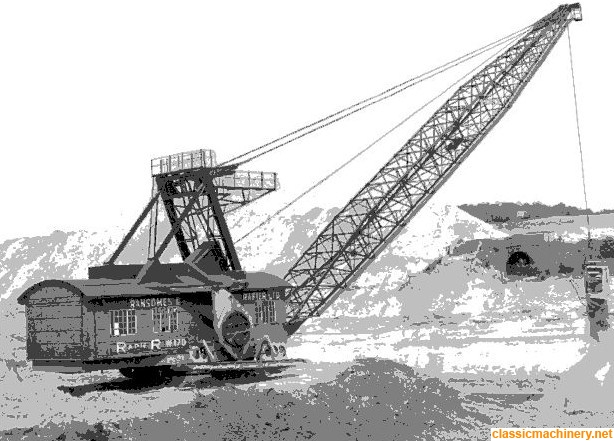
Thank you for your informative post on Ransomes & Rapier.
I know where you got your information from and I beleive some of it is incorrect. I even dispute some of the info. published in "The Bible," Keith Haddocks book "Giant Earthmovers."
I am lucky enough to have watched the W1800 working at Wimpeys MaesGwyn Cap Site in the 1960s and have made a point of researching the R&R range.
The W1400 was originaly designed as a 1400 ton machine. Whilst I appreciate that machine weights will vary according to configuration, a longer boom will obviously require heavier counterweight etc. My understanding is that "SUNDEW" The W1400 employed by the United Steel Co. at Rutland weighed 1,675 tons not 1880 tons as widely stated. She carried a 20 yard bucket and a 282 foot boom.
The basic W1800 weighed 1,790 tons without the bucket and had a 208 foot boom to which one of two extensions could be fitted. The shorter extension gave an opperating length of 247 feet and was used with a 40 yard (90ton) bucket.
The longer extension gave an opperating length of 282 feet and was used with a 30 yard (65ton) bucket.
There is far too much to post in one session so I will do a series of posts and pics to cover the R&R and NCK range from the very beginning.
Did you know the first R&R machines were first marketed as RRM and Newton Chambers as NCH??
The first R&R walker the W170 was built in 1937. She carried a 4 yard bucket on a 135 foot stick. I don't know much about this one but it used the Cameron & Heath walking gear design which R&R retained to the end.
This is the only pic. of the W170 I can find.

Last edited by FOWLER MAN on Fri Oct 30, 2015 3:11 pm, edited 1 time in total.
-
Jeremy Rowland
- Moderator
- Posts: 8677
- Joined: Sun Aug 05, 2007 8:36 pm
- Real name: Jeremy Rowland
- Has thanked: 1873 times
- Been thanked: 1692 times
Re: Early British walking draglines
LDK wrote:Didnt NCK stand for Newton Chambers Kohering?
Russ I think you're correct on that if not Fred will no doubt correct us
Jeremy
-
FOWLER MAN
- Posts: 2358
- Joined: Wed Dec 09, 2009 11:28 pm
- Real name: fred evans
- Has thanked: 1295 times
- Been thanked: 1111 times
- Flag:

Re: Early British walking draglines
LDK wrote:Didnt NCK stand for Newton Chambers Kohering?
Yes Russ, you are right, but Newton Chambers produced excavators before they entered into an agreement with Kohering to produce the Kohering designs under licence in1947.
Ransomes & Rapier first made excavators in1926 nearly ten years before N-C so we'll look at them first.
In 1926 R&R entered into an agreement with the American company Marion to produce Marion designed excavators under licence.
I have posted a couple of old adverts below which clearly establishes this link and shows some of the "Ransomes & Rapier-Marion, " (RRM), products with machines ranging from 1/2 to 15 yard capacity and up to 1400 tons in weight.
They also mention the availability of "petrol-electric and diesel-electric models, technology which no doubt paved the way to development of the all electric W170 walker.
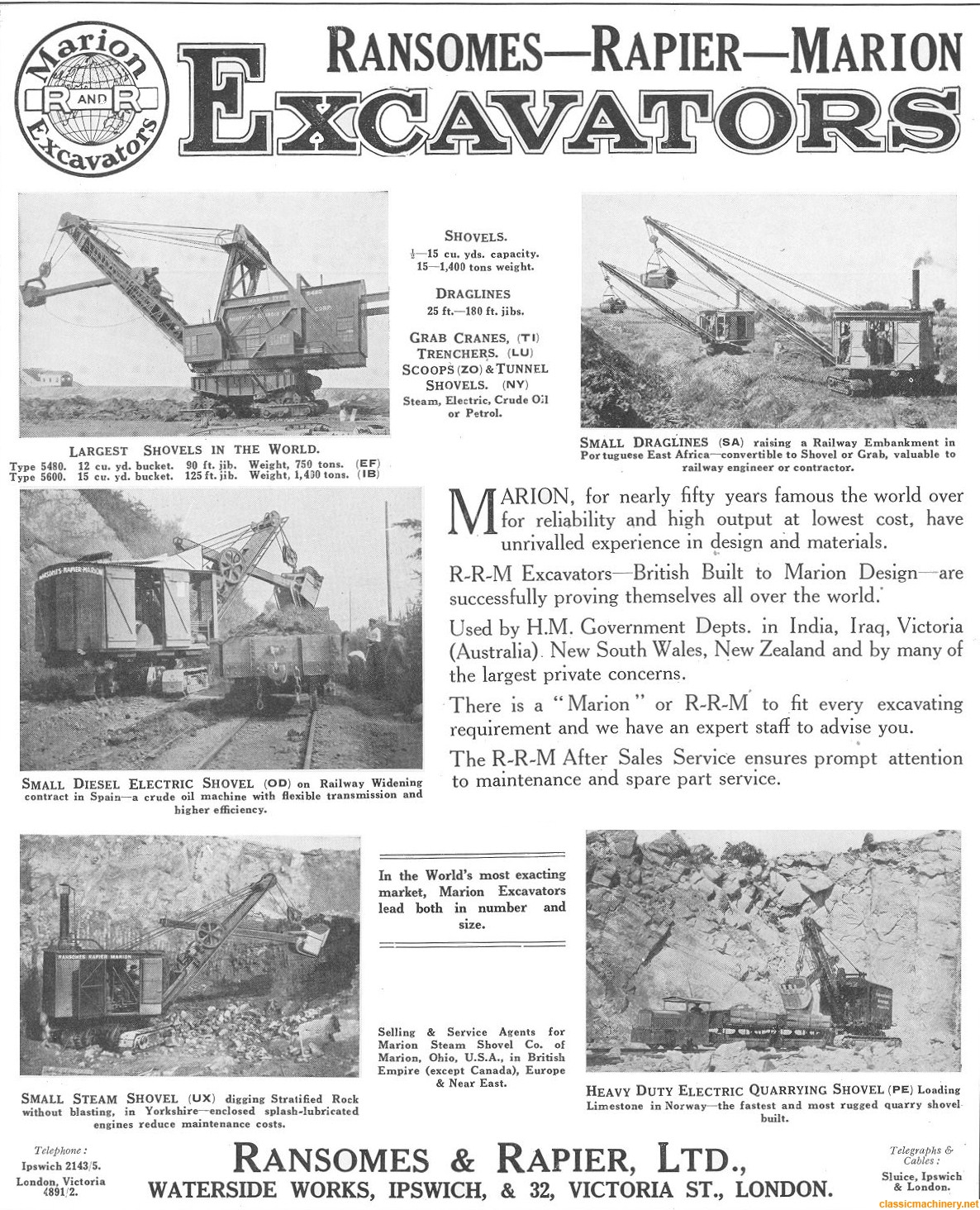
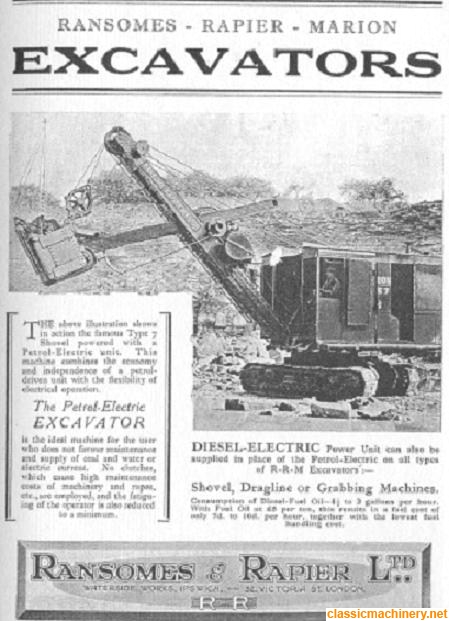
R&R had already been producing machines of their own design replacing castings with fabrications wherever possible before the agreement with Marion ended in 1936. That was just one year before the W170 went into service and it clearly inherited a lot of Marion design features.
R&R went on to produce more "Walkers" the W80 in 1940, this was a 2 yard machine and this was followed by the 2-1/2 yard W90 in 1943.
We will look at Newton Chambers in the next post and continue the R&R story. I have quite a bit of info on the build of the later machines.
Did you know R&R tried their hand at tractors?? See below.
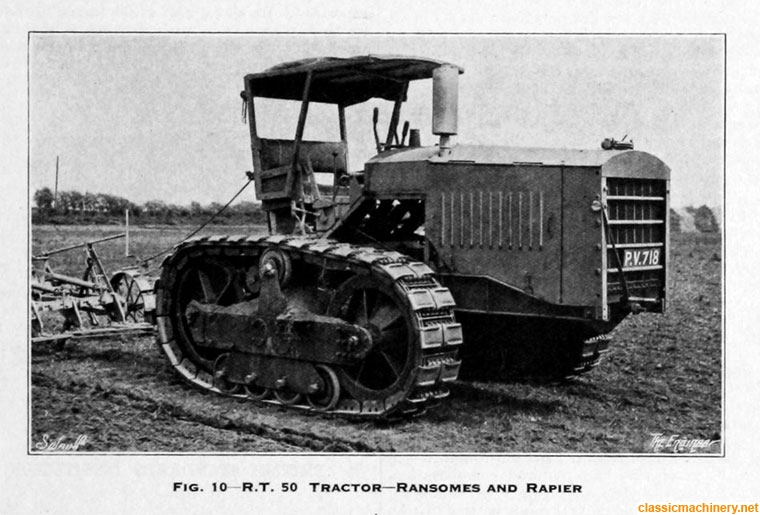
-
LDK
- Posts: 81
- Joined: Wed Aug 04, 2010 9:42 pm
- Real name: russ
- Location: Philippines
- Has thanked: 9 times
- Been thanked: 22 times
- Flag:

Re: Early British walking draglines
My late father used to drive draglines, faceshovels, backacters, skimmers, grab, and also did a lot of crane work in the 60s for different companies. He operated a 3W for WC French at one time, this was the only walker he operated that I know of, all the rest were on tracks and of various breeds.
A couple of years before he passed away he was shown around the Ace of Spades before it was dismantled and shipped to the States. He also corresponded with a guy over there who would send him updates and pictures of its reassembly.
Russ
A couple of years before he passed away he was shown around the Ace of Spades before it was dismantled and shipped to the States. He also corresponded with a guy over there who would send him updates and pictures of its reassembly.
Russ
-
FOWLER MAN
- Posts: 2358
- Joined: Wed Dec 09, 2009 11:28 pm
- Real name: fred evans
- Has thanked: 1295 times
- Been thanked: 1111 times
- Flag:

Re: Early British walking draglines
Hi,
To continue the story of "NCK Rapier."
In 1935 Nweton Chambers who had surplus foundry and engineering capacity decided to go into excavator production.
They entered into an agreement with the American manufacturers "Pawling & Harnischfeger," (P&H), to build machines under licence. These were marketed as "Newton Chambers Harnischfeger," (NCH).
They met with a great deal of success and by 1939 a new factory was built at Sheffield for excavator production, this was seriously curtailed when the factory was requisitioned for production of Churchill Tanks for the war effort and any excavators built then went to The Ministry of Defence.
The first NCH was a 1/2 yard universal machine with a Cat D4 power unit. Two models were produced, the NCH 125 and NCH 150, these were basicly the same machine with the 150 having an uprated D4 engine and heavier running gear giving it a bigger footprint.
In 1958/9 my work took me to the Steel Company of Wales Quarry at Stormy Down near Bridgend and there was an NCH on face shovel parked up there. I hardly noticed it in the shaddow of the 110 RB and 100 RB shovels though.
There was also one in use locally on a housing development.
Photographs are hard to find, but I have this one taken in 1947 on a job just 5 miles up the road from me. There's a fair bit of footage of one at work in The East Anglian Film Archive "City Engineers Work" Cat. No. 476.
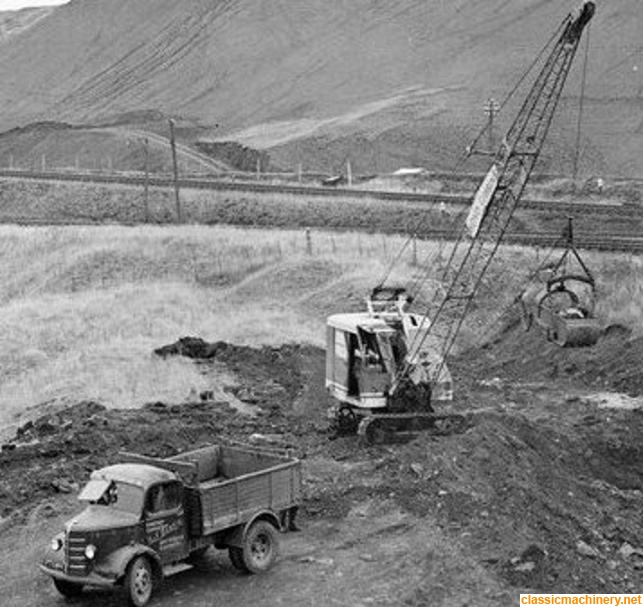
The agreement with P&H finished in 1946 and the following year a license agreement was entered into with Kohering and the first NCK the304 was built. For the British market this was available with Dorman, AEC, Thornycroft or Gardner engine.
At this stage Kohering, like P&H before them, had no financial interest in Newton Chambers.
More next post.
Fred
To continue the story of "NCK Rapier."
In 1935 Nweton Chambers who had surplus foundry and engineering capacity decided to go into excavator production.
They entered into an agreement with the American manufacturers "Pawling & Harnischfeger," (P&H), to build machines under licence. These were marketed as "Newton Chambers Harnischfeger," (NCH).
They met with a great deal of success and by 1939 a new factory was built at Sheffield for excavator production, this was seriously curtailed when the factory was requisitioned for production of Churchill Tanks for the war effort and any excavators built then went to The Ministry of Defence.
The first NCH was a 1/2 yard universal machine with a Cat D4 power unit. Two models were produced, the NCH 125 and NCH 150, these were basicly the same machine with the 150 having an uprated D4 engine and heavier running gear giving it a bigger footprint.
In 1958/9 my work took me to the Steel Company of Wales Quarry at Stormy Down near Bridgend and there was an NCH on face shovel parked up there. I hardly noticed it in the shaddow of the 110 RB and 100 RB shovels though.
There was also one in use locally on a housing development.
Photographs are hard to find, but I have this one taken in 1947 on a job just 5 miles up the road from me. There's a fair bit of footage of one at work in The East Anglian Film Archive "City Engineers Work" Cat. No. 476.

The agreement with P&H finished in 1946 and the following year a license agreement was entered into with Kohering and the first NCK the304 was built. For the British market this was available with Dorman, AEC, Thornycroft or Gardner engine.
At this stage Kohering, like P&H before them, had no financial interest in Newton Chambers.
More next post.
Fred
Who is online
Users browsing this forum: No registered users and 58 guests


